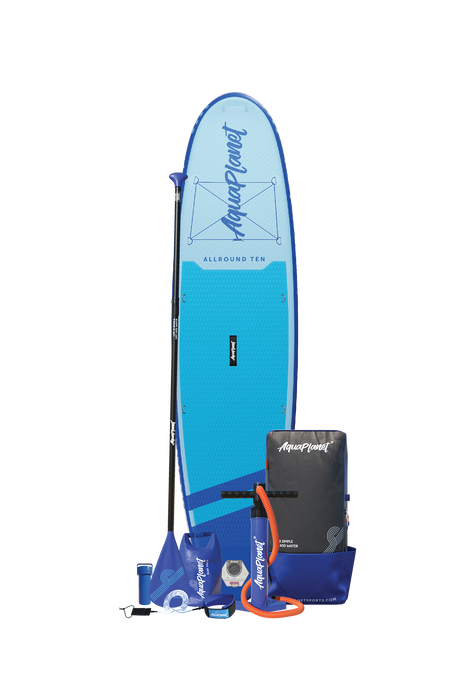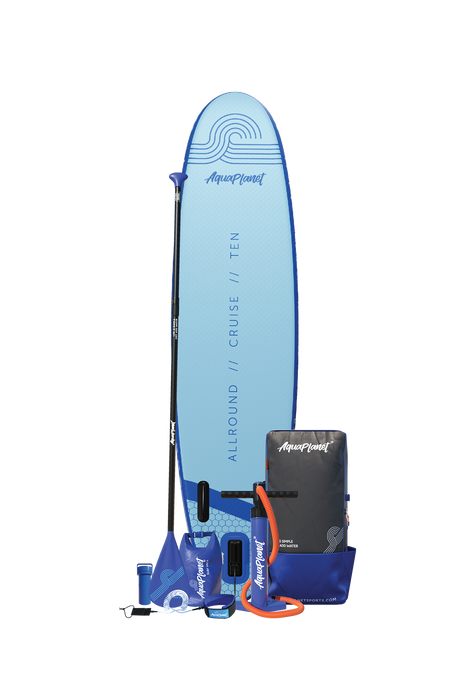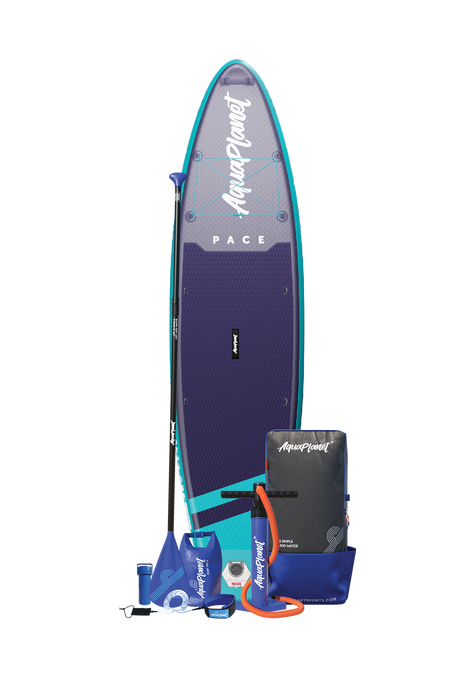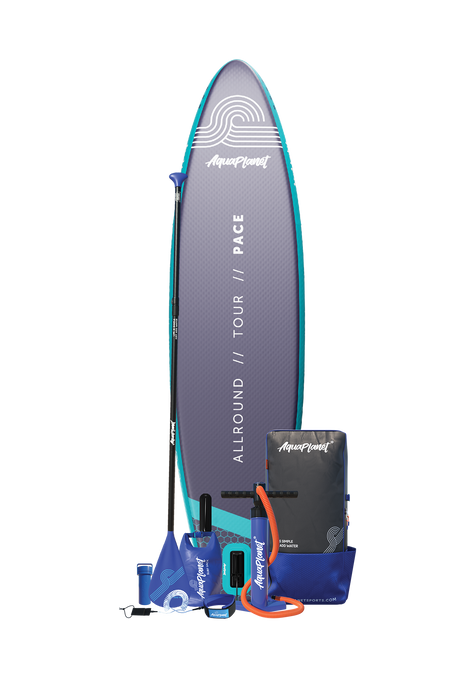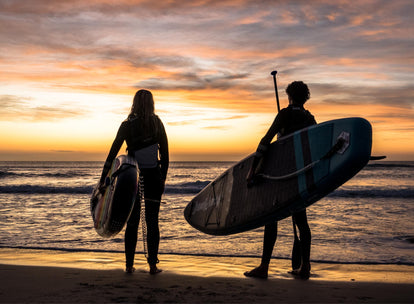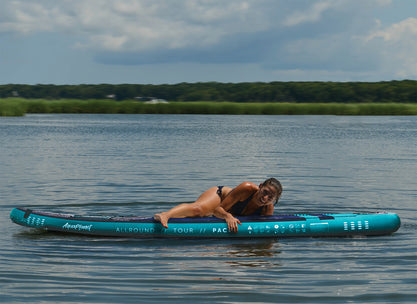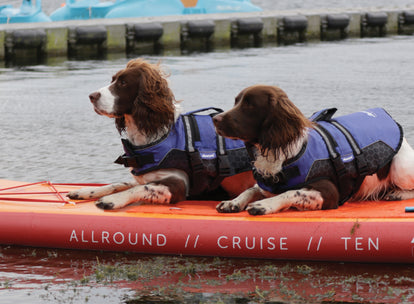You love to SUP, and you love your pup, so what could be better than teaching your pup to ride along on your paddle board adventures? Paddle boarding can be a great way for both you and your pooch to get exercise and enjoy time together in the great outdoors.
If you’re thinking of taking your dog out on the water, these tips will help make teaching your dog to ride on your stand-up paddle board easy, safe, and fun for both of you. These apply to rivers, seas or lakes.
Choosing the right paddle board

Paddle board size
The best paddle boards for dogs are wider and longer boards because they are more stable. When you’re choosing a paddle board for you and your dog, it’s best to look at a board that is at least ten feet long and 32 inches wide. Paddle boards over ten feet long are the most stable, which makes them a good choice when you’re taking your dog along for the ride. When choosing a board, make sure you consider your weight, as well as the weight of your dog. The larger the dog in comparison to the board, the more unstable it will be. Paddle boarding with large or multiple dogs is no problem as long as you have the right board.
SUP surface grip
Many paddle boards may not provide much grip for your dog's paws. Get a paddle board with a dog appropriate grip to make sure your buddy doesn’t go sliding off when you hit a wave. The best SUPs for dogs are boards that have a full deck pad, or at least an extended deck pad. Inflatable boards typically come with extended deck pads. If your board does not have a large enough deck pad, there are other options. Old yoga mats or bath mats with suction cups are great alternatives.
SUP Pet Buoyancy Aids

Many dogs are good swimmers, but since the paddle board adds an element that your pooch isn’t familiar with, it’s a good idea to get them a life jacket. A dog jumping off a tipping paddle board could get disoriented and panic. Be sure to try a buoyancy aid on your dog at home first to make sure it fits and so they can get used to it before going in the water.
Introducing your dog to the paddle board
Paddle boarding can be an overwhelming experience for your dog. Things as simple as wearing a life jacket or standing on the board can increase fear if these experiences are new to them. To make the transition as smooth as possible, use these tips to introduce your dog to the sport.

1. Don’t get on a SUP with your dog until you’re confident using one by yourself.
You should be comfortable standing up, paddling, and turning. Make sure you can also fall and get back on from the water. Dogs will mirror your stress if you are not comfortable and being on a stand up paddle board with a dog in tow will only make things more difficult for beginners.
2. Before hitting the water, introduce your dog to the board on solid ground.
Put the board in an area of the house where your dog is comfortable. Allow them to sniff it, look at it, and explore it on their own terms. It’s not a problem if they don’t jump right on at first - it’s just there for them to get used to.
3. Once the board has been in the house awhile, put a treat on it to encourage your dog to walk on.
Encourage them onto the paddle board and then tell them to sit, then reward them with a treat. After repeating this they should be somewhat comfortable with the board. Take it slow and don’t force them. The paddle board should be fun for the dog, they shouldn’t feel afraid or pressured.
4. Teach your pup to jump off the board only when commanded, and reward them.
A lot of the time dogs get excited and jump off the board when you’re getting close to shore/river bank. This can throw you off balance and into the water, which can be more dangerous near the shore/river bank.
Preparing to SUP with your dog
Now your dog has become comfortable being around the paddle board, it is time to prepare them for your SUP trip.

1. Make sure your dog can swim
Before paddle boarding with your dog, ensure they are comfortable swimming. If they are a weak swimmer or afraid of water, the experience will not be enjoyable. Allowing your dog to swim on their own several times should be enough to help them get over any fears. If they just can't get used to the water on their own, consult a dog trainer for advice.
2. Trim sharp nails
Anyone who has ever been swimming with a dog knows that shorter nails are better than long, sharp ones. By keeping your dog's nails short and dull, you will minimise the chance of the finish of your board getting scratched, or your deck pad torn.
3. Bring a pocket full of treats
Bring treats out on your adventure to continue rewarding good behaviour. That way, if your dog likes to jump off into the water when they’re not supposed to, you can train them to be a better passenger over time.
4. Tire out energetic pups
Play a game of fetch or go for a swim together before getting on the board to tire your dog out. Energetic dogs do not like to sit still on SUPs, which makes it hard to keep your balance. A tired dog is less likely to throw both of you into the drink.
How to paddle board with your dog

Now that your dog is comfortable on the paddle board and you have prepped them, it is time to go paddle boarding!
- Have your dog stay on shore as you go out on the board. Wave to them, laugh, and smile so they know that it is fun and not scary.
- Hold the board still in shallow water and allow your dog to get on. Walk the paddle board through the shallow water and allow them to jump off if they want.
- When you’re both ready, get onto the board with your dog. Start out paddling on your knees for better balance.
- Stand up with your dog between your feet. Get used to paddling without accidentally hitting them with the paddle.
- Small dogs can sit on the nose of the board. Once you’ve mastered keeping the paddle away from your dog, they can sit in front of you on the board. For better weight distribution and balance, large dogs can sit on the back third of the board.
- Keep it short the first time out. When you get back to shore, reward your dog and give them praise. It may not go perfectly the first time out, but it’s all part of the learning experience.
- Be prepared for your dog to jump off at any time. The board will move a lot when a large dog jumps off, and when it happens you may fall in as well. Make sure that you’re only standing on the board when in deep enough water and away from any hazards like boats or people.
- If your dog jumps or falls off the board, help them back on the board. This will help make sure they don’t scratch the board’s finish trying to get on. Life jackets will usually have handles for you to grab onto.
- Bring water out for both of you. If you are paddling on the ocean, your dog might try to drink the salt water. Taking in too much salt water can cause further dehydration (and other health issues). Changes in mood or behaviour may be an early warning sign of salt or river poisoning.
Safety tips for SUP’ing with your pup
-
Bring a first aid kit
If you’re going for several hours, bring along a portable first aid kit. Paddle boarding should be fun and relaxing - you don’t want to be rushing back to treat injuries. First aid kits can also help you make temporary repairs to torn or damaged equipment
-
Apply sunscreen to your dog
Dogs are at risk of sunburn just like humans, especially on their bellies. Some dogs have a very thin layer of fur in that area and can be burned by sunlight reflected off the water. Apply sunscreen to any exposed areas and try not to spend more than a couple hours in the sun at a time.
-
Kneel or sit near hazards
Only stand on the board when in open water, away from; pontoons, slipways, docks, shallow water, boats, people, or any other potential hazards. This is always recommended when paddle boarding, not just when you’re with a dog. However, it is especially applicable with a pooch that could throw off your balance at any time.
-
Rinse your dog afterwards
Paws and skin can be irritated by salt. After being in the water, rinse the sand and salt water off, and make sure not to neglect the ears. Ear infections can result if water is left trapped in your dog’s ears.
-
Be aware of beach/river hazards
If you are out on the ocean, sea lice can irritate dogs and jellyfish pose a hazard for both of you. Hot sand can also harm your dog’s paws. If they are standing on the beach, try to keep your pup in the shade or even in ankle-deep water. If you are on a river, be careful of other wild life which can be tempting for your dog to chase. Also, river water could be dirty, so bring your dog up on the board as soon as possible if they accidentally swallow too much. If they start feeling unwell, do take them to a vet when needed.
-
Never leave your dog alone in a vehicle
We all know this, but it’s always worth remembering! In the warm weather, it can only take a matter of minutes for a dog to get heat stroke if left in a car unattended. Only have pets in the car if you’re in there with them with the windows open or air conditioning on.
Pro Tip: be patient. Not all dogs were born to ride. If it isn’t clicking, don’t force it. Getting frustrated will make the experience unenjoyable for both of you.

